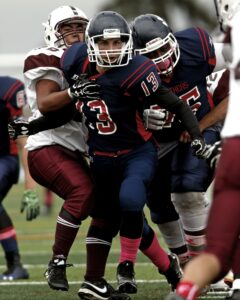Origin of College Football and Different Divisions

Table of Contents
How College Football Divisions Lead to the College Football Playoff Schedule
Division 3 schools
Division 3 schools in college football are very selective. Only about one in thirteen high school athletes make it to these programs. These schools have the highest GPA requirements and focus on regional recruits. In addition, D3 teams don’t offer athletic scholarships. Instead, they offer a combination of need-based financial aid and academic scholarships. These financial packages may be better than a small athletic scholarship offered by a D2 school.
There are approximately 250 NCAA Division 3 football programs in the United States. These programs are affiliated with different conferences. These schools are mainly private schools, with a few public schools. Typically, these schools play 10 games in the regular season and 32 games in the playoff bracket. Their stadiums have a capacity between two and five thousand seats.
Division 3 schools in college football are known for their smaller size and emphasis on academics. They are still competitive and provide a traditional college experience. They often have smaller student bodies but play for a smaller, competitive field. As long as the football team is competitive, athletes may find a better fit in a Division 3 school than with a D1 team.
Division III coaches are usually a little more relaxed than those in the other divisions. They may only have a handful of assistant coaches, and they may be part-time employees or volunteers. The competition level in the DIII division is considerably lower than that of the other two divisions. That said, it’s still a competitive environment, especially if you are a student-athlete who dreams of playing in the NFL.
Division 3 is the lowest division in college football. These teams compete in mid-major conferences. As such, they don’t have the large budgets of Division 1 schools, but they can still field a good team. If you’re looking for an affordable school, Division 3 is a good option.
Despite its lower competitiveness, Division III schools offer an excellent balance of academic rigor and competitive football. Many DIII schools do not offer athletic scholarships. Most of their financial aid comes from academic scholarships.
College Football Touchback rules
Touchback rules for college football are fairly traditional. In the first few years after the game was invented, any kick that went out of bounds in the end zone was a touchback. However, in the last few seasons, the rule has undergone some changes. First, the NCAA moved the ball to the 25-yard line after the 2012 season. Then, in 2016, the NFL followed suit.
Today, the NFL is the leading voice of American football. The NFL rules extensively on touchbacks. Touchbacks can be either offensive or defensive. It may result from a fumble or a rollout of the ball. In the former case, the receiving team must stay behind the goal line, and must not go back into the end zone. In the latter case, a safety will be called.
The NCAA Football Rules Committee recently proposed a change to the kickoff rule. If a kickoff returner catches the ball within the 25-yard line, he may signal “fair catch.” In this case, the ball is placed on the 25-yard line. This rule change is intended to increase the number of touchbacks while reducing the number of injuries that occur during kickoff returns.
Touchback rules have undergone several changes over the years. The NFL moved kickoffs from the 35-yard line to the 25-yard line, and the NCAA adopted a similar approach in 2016. The changes were made permanent in 2018. The changes were implemented in response to concerns over player safety. The NFL also approved a package of rule changes regarding blocking below the waist.
Touchbacks are most common on kickoffs and punts. In practice, a receiving player can force a touchback by kneeling in the end zone. Once the ball crosses the goal line, it becomes dead and the kicking team can recover the ball and score a touchdown.
Touchbacks are a vital part of football. When a team is awarded a touchback, it will start a new offensive drive from the 20-yard line.
Origins of American football
Origins of American football in college football began with the meeting of Princeton and Rutgers in the early nineteenth century. In 1870, Columbia was invited to play and the game became popular. From there, the sport spread throughout the United States. Today, college football is played by teams of college students from different colleges and universities.
The rules of American football were developed by students at eastern universities after the Civil War. In 1867, the students of Princeton University set up the first games with distinct rules of play. These intramural games were difficult to organize, so the colleges decided to create the rules. In 1873, the Ivy League took up the game, and American football became the dominant sport in college campuses.
By the 1890s, the game became popular and was played at many universities across the United States. By that time, many colleges and universities had their own teams. By the end of the century, the game was played in 432 different cities. In addition to the first game, college students helped design the first uniform and rules of the game.
In the early 1920s, college football was more popular than professional football. When this happened, a group of independent team owners came up with the idea of forming a strong professional league, similar to that of baseball. This organization, called the American Professional Football Association, was founded by Jim Thorpe and was renamed the National Football League (NFL) in 1922. However, the league was not the NFL that we know today.
The offensive line is made up of several players. Their main function is to block the defense. The center is the leader of the offensive line. This player is responsible for snapping the ball to the quarterback, blocking, and making sure the other linemen are doing their job. In addition to the center, there are guards and tackles.
College football is an adaptation of the game of football, which originated in America. It is played on a rectangular field with goalposts at the ends. The object of the game is to score more points than the opposing team within a given time limit.
Division 1 teams
There are many different advantages to playing for Division 1 teams in college football. These programs are run by the NCAA and require athletes to meet specific athletic and academic requirements. For example, athletes must have a minimum SAT/ACT score or a national letter of intent to be considered. The NCAA also requires that athletes be declared eligible for play by the NCAA Eligibility Center before they can attend a Division 1 school.
The average student-athlete and school experience are similar, but there are some differences between the different levels. Division 1 teams typically have a lot of money and can offer full athletic scholarships to their players. They can also provide new clothes and equipment each year and have top-notch facilities. The NCAA has a comprehensive guide for student-athletes looking for college athletic scholarships.
The NCAA’s football rules prohibit schools from dropping from Division I to Division II, but the schools that are transitioning can’t play in the playoffs. For example, North Dakota State was ranked third in 2006, but will not be eligible for the playoffs until the 2008 season. Service academies were briefly considered for I-AA status, but a recommendation by the Pentagon kept them in the top division.
The schedules for Division 1 teams are extremely rigorous. The football season can be very competitive, and many players don’t see playing time until their senior year. Therefore, it’s important to be prepared to work hard. In addition to the hard work, players must have an intense love of the game to play on a Division 1 team.
When considering college football scholarships, don’t forget about how selective Division 1 teams are in recruiting new players. On average, only one out of every hundred high school athletes can make it onto a Division 1 team. The NCAA sets a limit on how many players each program can accept as a full scholarship.
The football competition at the Division I level is divided into two main divisions, the Football Bowl Subdivision (FBS) and the Football Championship Subdivision (FCS). FBS teams have higher attendance requirements and more athletes receive athletic scholarships than the teams in Division I. Their post-season bowl games are televised, and their postseason schedule includes a few bowl games. The FBS championship is decided by a four-team playoff bracket.




